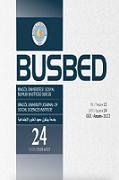ÇAPAKÇUR (BİNGÖL) İSFAHAN BEY CAMİİ VE ZAVİYESİ VAKFI
FOUNDATION OF ISFAHAN BEY MOSQUE AND ZAWIYA IN ÇAPAKÇUR (BİNGÖL)
Author(s): Yaşar BaşSubject(s): Islam studies, Government/Political systems, 16th Century, 18th Century
Published by: Bingöl Üniversitesi Sosyal Bilimler Enstitüsü
Keywords: Çapakçur; Isfahan Bey; Foundation of Isfahan Bey Mosque and Zawiya; Abtor Village;
Summary/Abstract: Isfahan Bey was the governor of Çapakçur shire and its environment during and before the Ottoman administration. He had a mosque and a zawiya built in the village of Abtor, close to the central region of Çapakçur. He legitimately donated the buildings, structures and lands in the village to the Abtor Mosque and Zawiya as a foundation. The functioning of the foundation, income and expense accounting, appointment of officials and salary payments were determined according to the foundation conditions of Isfahan Bey dated May 1548. Foundation mosques, zawiyas and landed properties played an important role in meeting the religious and social needs of the region. Isfahan Bey passed away about six or seven months after he registered his foundations. After his death, the registration process, which was started in Çapakçur shire, took about a year by completing on May 18, 1550. The summary of this book was prepared in the next two months. Meanwhile, after the death of Isfahan Bey, the Çapakçur shire principality remained empty for ten to eleven months. In November 1550, Timurtaş Bey was appointed as the governor of Çapakçur. Timurtaş Bey served as a banner lord here for more than nine months. After him, the governors, who were from different places but not from the Suveydi dynasty, were sent to the Çapakçur shire at short intervals. Later, Isfahan Bey's eldest son Maksud Bey was assigned to the Çapakçur region as a member of the Çapakçur dynasty. Isfahan Bey Foundation experienced some problems after the death of its founder. The mosque and zawiya operating in Abtor Village, presumably in the 1750s, were on the verge of demolition due to lack of ownership or neglect, and could not serve. As well, the foundation administration centre and its properties had similar problems. The historical mosque, which is present in the Lower Bazaar (Aşağı Çarşı) area today, is the only work that keeps the memory of Isfahan Bey alive. The people of Çevlik had the mosque of the same name built in the 1750s by carrying the remains of the mosque in Abtor, which was on the verge of collapse. The administration, officials and revenues of the Isfahan Bey Foundation were also allocated to this new mosque. Due to the appointment of a foundation officer and the income and expense accounts found in the 19th century, the income source, amount, officials, repair, furnishing and other expenses of the foundation could be found. According to the same findings, there have been many disputes over the ownership, administration, use and sharing of foundation assets.
Journal: Bingöl Üniversitesi Sosyal Bilimler Enstitüsü Dergisi (BUSBED)
- Issue Year: 12/2022
- Issue No: 24
- Page Range: 342-363
- Page Count: 22
- Language: Turkish

